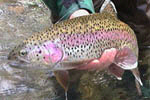Fly Tied By:
Mike Johnson
Story By:
Mike
Home: Avondale,
Arizona
E-mail: mgjaej@yahoo.com |
Mike began flyfishing in the early 1990's. He remembers his early
attempts, and the sound skunkings he received on the San Juan
River. Mike fishes throughout the west and especially
the southwest. His obsession with fly tying began
in 1997, and he currently puts in 20+ hours a week at the
bench. Mike is an elementary school
teacher in Phoenix, Arizona. |
My wife and I enjoy renting a
cabin on the banks of a fine trout stream in the White Mountains of
northeastern Arizona. These waters are home to some large brown
trout with a nice population of rainbows as well. I can usually
tempt some of these larger specimens at night with a Zonker or some
other large streamer, though catching them in the daylight hours is
a different story altogether.
I was having a rough morning,
puttering around with a Stimulator dropper with a nymph beneath it.
I was, in fact, getting skunked. My wife wandered down to the river
from our cabin to watch me. I told her, "watch this, Iím going to
try something silly," and tied on a Chernobyl Ant. I cast it out to
the middle of the stream and BOOM. The instant it hit I was hooked
up to a beautiful, fat 23" brown. My wife walked back up to the
cabin and shortly returned with her rod strung up and asked me for
one of "those foam ants." We were hooked up consistently for the
next two days.
Ever since that happened, the
Chernobyl Ant has become my go-to searching dry fly. Iíve always got
a few in my box and will not hesitate to use
one.
--Mike Johnson
Hook: Tiemco
300, size 10.
Thread: Black Kevlar, size
"g".
Underbody: Mono (about the diameter of the
hook shank or slightly thinner) tied in along both sides of the
hook shank, to prevent the foam body from rotating on the
shank.
Body: Tan foam strip tied to
create segments (as shown below), with black foam strip tied in on
the top of the shank in two location. Note that the ends of both
foam strips are angled with scissors.
Legs: Round white
rubber.
Strike Indicator/Wing:
Yellow foam, or other visible color.
Hackle: Black dry fly hackle tied in
parachute style helps fly land
right-side-up.
|
|



